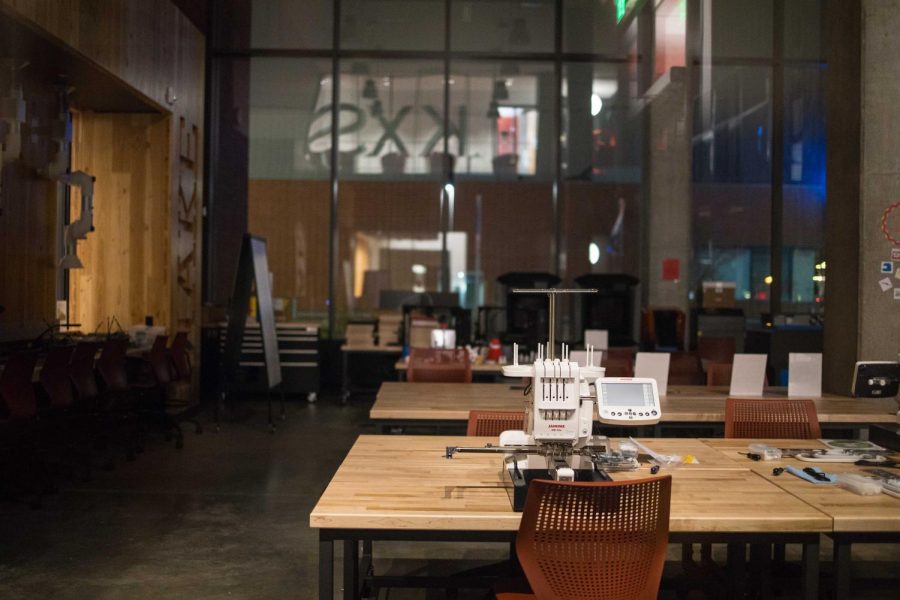Billodue Makes Space for Student Creativity
Sewing machines in Maker Space
Long before Seattle University broke ground on the Center for Science and Innovation (CSI) in 2019, eager staff members came together with a vision for the Billodue Makerspace. Now planning their soft opening for Feb. 1, the collaborators who brought the idea to life shared a bit about the journey and what to expect in the Makerspace.
The Lemieux Library and McGoldrick Learning Commons were not originally included in the CSI building conversations. However, when the Dean of Lemieux Library, Sarah Barbara Watstein, and the Director of Library Systems, Technology and Media, Doug Eriksen, learned more about the vision for the CSI and the makerspace, it piqued their interest.
“Doug and I—as we learned more about what was envisioned for the CSI—we made a pitch that the library was uniquely suited to further develop the vision for that space, because the equipment, tools and management of the space was within our wheelhouse,” Watstein said. “For us, it seemed like a natural extension.”
Lemieux’s Learning Commons inspired the duo and the concept behind the makerspace. Drawing inspiration from the Media Production Center (MPC), Watstein and Eriksen made their pitch to Michael Quinn, Dean of the College of Science and Engineering.
“The space as it was envisioned, would be open to all members of the university community and be an inclusive space, versus exclusive to just science and engineering or the more traditional science and engineering disciplines,” Watstein said.
Since the opening of the CSI building in September 2021, a team of Student Creators have been hired; these student workers have been learning how to use the equipment and tools and developing skills to support the activities in the space.
Nick Ames was recently added to the team as the Manager of the Media Production Center and Billodue Makerspace, though he had been involved in conversations about the makerspace since before construction began. He stated that additional Student Creator positions are available as an expanded team will support proposed hours.
Watstein, Ericksen and Ames plan to have the Billodue Makerspace run like the MPC in encouraging collaboration with faculty, workshops, one-on-one or small group training opportunities that could be coordinated through a class.
“The difference in the models between the two spaces is that one of the biggest services out of the MPC is the equipment borrowing. This makerspace equipment is in the makerspace,” Ericksen said.
Makerspace staff created a badge system where students can enroll in a Canvas course and take classes based on the equipment they plan to use for their projects. The badge would be earned so that the Billodue Makerspace staff and Student Creators know what equipment students have clearance to use.
“It is a product-and-success-based procedure to give you all the information that you need to be successful and then provide you with a badge so that you can come in and work independently once you’ve been onboarded,” Ames said.
The makerspace will offer a variety of equipment for students to use. Some of the equipment includes 3D printers, tools for bike repair, sewing machines, embroidery machines, a laser cutter, and various laptops.
All PPE and necessary safety equipment will be provided for students. There are lockers within the space that can be used for short durations at a time so students can leave projects with multiple parts or that don’t fit in their backpacks in the building.
Ames touched on how the team is still developing the model Billodue Makerspace will use to ensure that students have access to supplies and materials. Watstein noted the importance of alignment with the mission and vision of Seattle U in thinking about removing barriers to access for students to enjoy the space.
“It is a new concept to the libraries to have a space where you buy a bunch of things [materials], and then they disappear. I am personally committed to lowering the financial commitment that a student needs to make to come into these spaces and be successful,” Ames said.
Ames discussed that they plan to organize the individuals using the makerspace by allotting time slots in their calendar for drop-in projects, workshops, or student clubs.
The Billodue Makerspace is still working to adapt to the current, ever-changing environment and are looking to expand their team, starting with a Makerspace Specialist. Students interested in staying involved with the Billodue Makerspace can visit their website and follow their social media. Their Canvas site is also open, so eager students can start earning badges.


